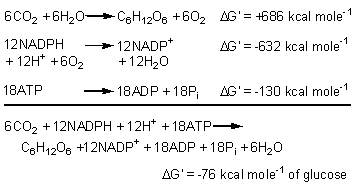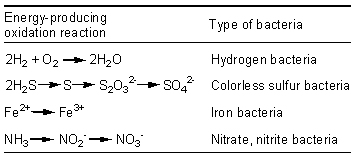|
The dark reactions can be summarized as follows:
The reaction Of C02 with NADPH by itself would lack 54 kcal of being spontaneous, but the addition of 18 ATP as an energy source makes the overall process spontaneous by 76 kcal of free energy. The light reactions are not really connected with glucose synthesis except as a continuous source of ATP and NADPH. In the light reactions, light energy trapped by chlorophyll or by various carotenoids is funneled to chlorophyll and then used as a free energy source to synthesize ATP and to reduce NADP+. These molecules then are used to power the dark reactions. |
Chemosynthetic bacteria have developed ways of obtaining ATP and NADPH by oxidizing inorganic substances. With these sources they then can use the dark reactions to synthesize glucose without any dependence upon light. Some of the inorganic oxidation reactions are given below. As far as we can determine, chemosynthesis is not in any sense an ancestor of photosynthesis, but is a late, special adaptation used by a few bacteria to exploit special energy-rich environments. However, chemosynthesis in bacteria does emphasize how tenuous the connection is between the light reactions and the dark reactions of photosynthesis, and how well the latter can function if given some other source of energy (ATP) and reducing power (NADH or NADPH). |

